Gallbladder Meridian of Foot-Shaoyang is one of the twelve meridians of thebody. It is commonly used for migraine,cold,malaria, jaw pain, eye pain, underarm swelling, scrofula, chest, flanks, ribs, hips, lateral knees, lateral calves,pain. There are 44 points in one side of this meridian, 88 points in the left and right.
Gallbladder meridian Pathway
Gallbladder Meridian originates from the outer corner of the eye (Tongziliao), reaches the frontal corner, descends to the back of the ear (Fengchi), from the side of neck, through the shoulders, and enters the supraclavicular fossa. The straight goes to the armpit, along the side of chest and abdomen, where the hip joint intersects with the branch of outer eye, and then goes along the lateral midline of the lower limbs,Passing through the fron of lateral malleolus, along the back of foot to the outer end of the fourth toe of foot (ZuQiaoyin).
There are three branches:one goes from the ear (Fengchi) through ear and passes through the front of ear to outside the corner of eye;other branch from the outer corner of eye and goes down to Daying acupoint,intersects with the Sann Jiao Meridian of Hand-Shaoyang under the eye socket,enters the supraclavicular fossa through Jiache point and neck, continues down the chest, pass through diaphragm, collateral liver belongs to Gallbladder, along the flank to Qichong point, and cross into the hip joint (Huantiao);Another branch is from the back of foot (ZuLinqi), along the first to second metatarsals to the back of thumb (Dadun), and connects to the Liver Meridian of Foot-Jueyin.
Gallbladder Meridian Points
GB 1 Acupuncture Point(Tongziliao)
Location:0.5 cun lateral to the outer canthus of the eye in a depression on the lateral side of the orbit.
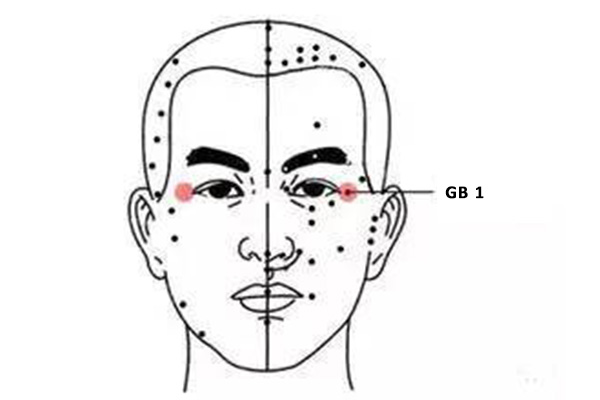
Usage:
- Eye diseases such as swelling and pain of eye;
- Headache, facial paralysis.
Clinical
Keratitis, myopia, neurological atrophy, trigeminal neuralgia, facial nerve palsy, etc.
GB 2 Acupuncture Point(Tinghui)
Location:Anterior to the intertragic notch at the posterior border of the condyloid process of the mandible (located with the mouth open).
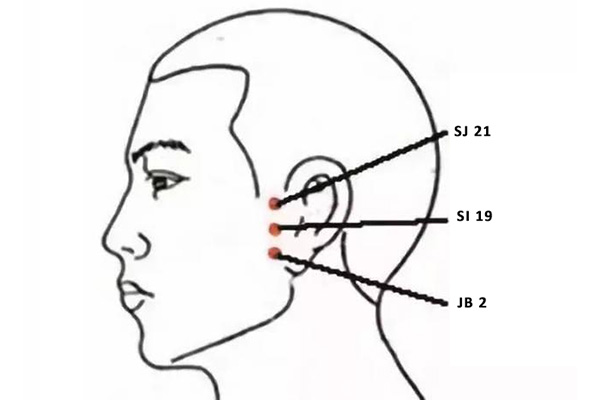
Usage:
1. Ear diseases such as tinnitus, deafness;
2. Tooth pain,facial paralysis, facial pain.
Clinical:Neurotic tinnitus (deafness), otitis media, facial nerve palsy, trigeminal neuralgia, etc.
GB 3 Acupuncture Point(Shangguan)
Location:In a depression directly above ST 7 on the upper border of the zygomatic arch, in front of the ear.
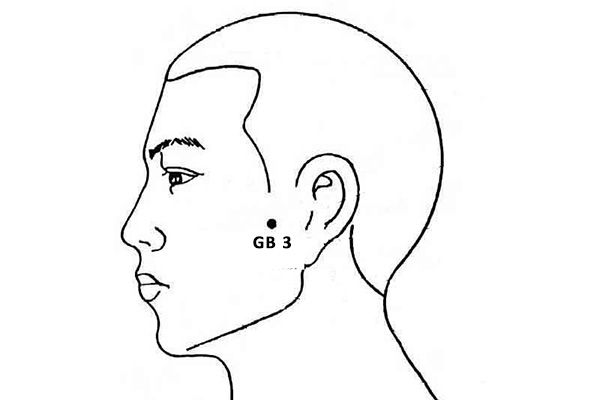
Usage:
headache, tinnitus, deafness,tympanitis,facial paralysis, facial pain, tooth pain, epilepsy, and cripples.
Clinical:Temporomandibular joint dysfunction,Vascular headache, trigeminal neuralgia, facial nerve palsy, etc..
GB 4 Acupuncture Point(Hanyan)
Location:Within the hairline of the temporal region at the junction of the upper 1/4 and lower 3/4 distance between ST 8 and GB 7.
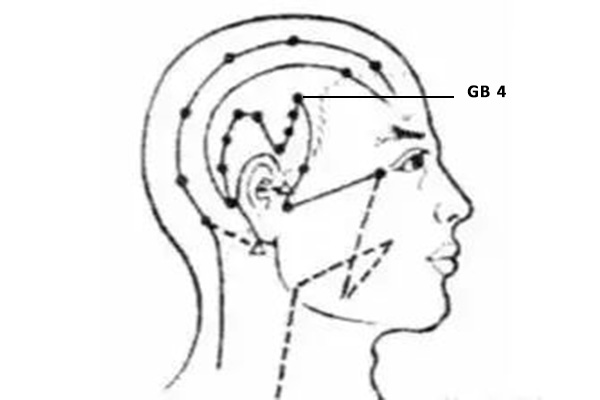
Usage:
migraine, dizziness, tinnitus, toothache, facial paralysis, epilepsy.
Clinical:Vascular (neurological) headache, neurological tinnitus (deafness), tenderness, etc.
GB 5 Acupuncture Point(Xuanlu)
Location:Within the hairline, midway between ST 8 and GB 7.
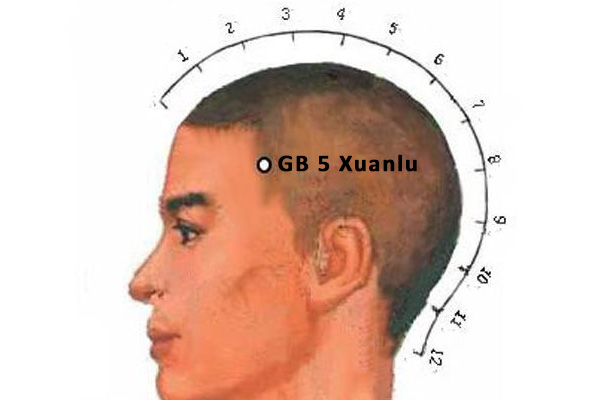
Usage:migraine, swelling and pain of eye, and toothache.
Clinical: stroke hemiplegia, trembling.
GB 6 Acupuncture Point(Xuanli)
Location:Within the hairline at the junction of the lower 1/4 and the upper 3/4 distance between ST 8 and GB 7.
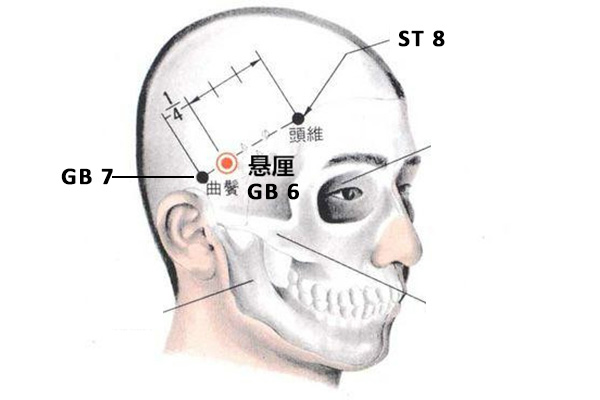
Usage:
Migraine, toothache, swelling and pain of eye, tinnitus and other facial disorder.
Clinical:Vascular (neurological) headache, cerebrovascular disease, temporal muscle spasm, etc.
Location:On the head at the crossing point of the vertical posterior border of the temple at a horizontal line through the ear apex (1 fingerbreadth anterior to TH 20).
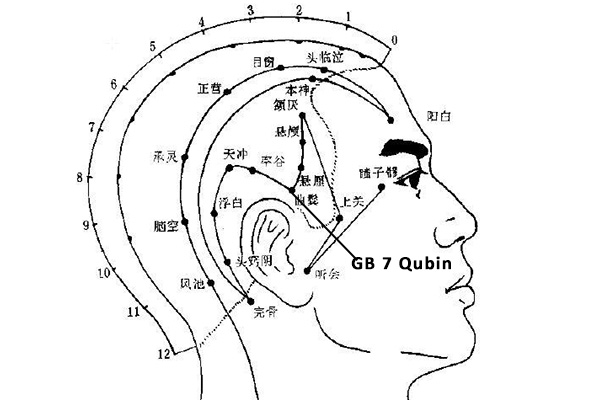
Usage:
- Migraine, toothache, swollen jaws and cheeks, swelling and pain of eye,and other facial disorder;
- Dizziness.
Clinical:vascular (neurological) headaches, cerebrovascular diseases, trigeminal neuralgia, etc. Acupuncture GB 7 can significantly improve cell aggregation, improve blood vessel elasticity, and reduce blood viscosity.
GB 8 Acupuncture Point(Shuaigu)
Location:Superior to the apex of the auricle, 1.5 cun within the hairline (1/2 ear length from the apex).
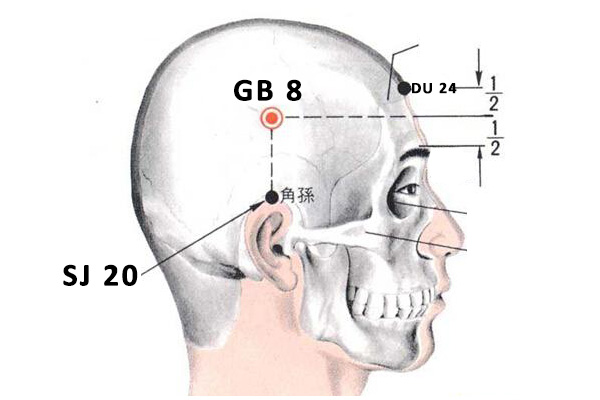
Usage:
- Headache, dizziness, vomiting, convulsion.
- Migraine, trigeminal neuralgia, facial nerve palsy;
- parietal pain, gastritis, febrile convulsion of children.
GB 9 Acupuncture Point(Tianchong)
Location:0.5 cun posterior to GV 8, 2 cun within the hairline, directly above the posterior border of the auricle.
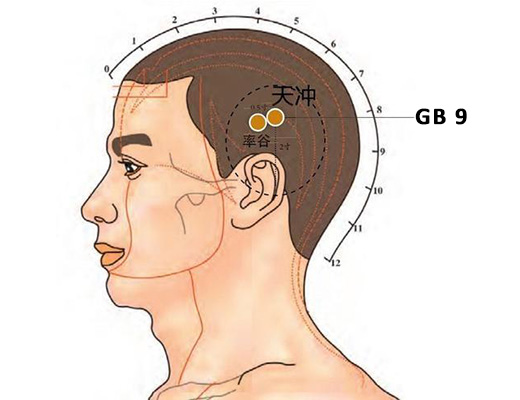
Usage:
1. Headache;
2. Tinnitus, deafness;
3. Thyroid disease;
4. Panic, epilepsy.
Clinical:Vascular (nerve) headache, neurotic tinnitus (deafness), goiter, etc.
GB 10 Acupuncture Point(Fubai)
Location:At the midpoint of the curve from GB 9 to GB 11, posterior and superior to the mastoid process, at the junction of the middle 1/3 and upper 1/3 of curved line connecting GB 9 to GB 12.
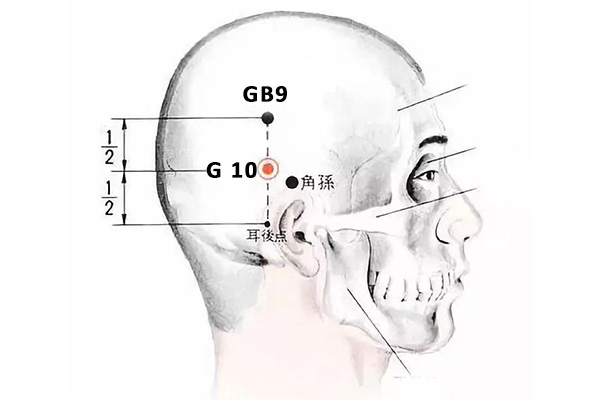
Usage:
1. Headache, dizziness;
2. Deafness and tinnitus;
3. Thyroid disease, scrofula.
Clinical:Vascular (neurological) headache, neurological tinnitus (deafness), etc.
GB 11 Acupuncture Point(TouQiaoyin)
Location:Posterior and superior to the mastoid process at the junction of the middle 1/3 and lower 1/3 of a curved line connecting GB 9 to GB 12.
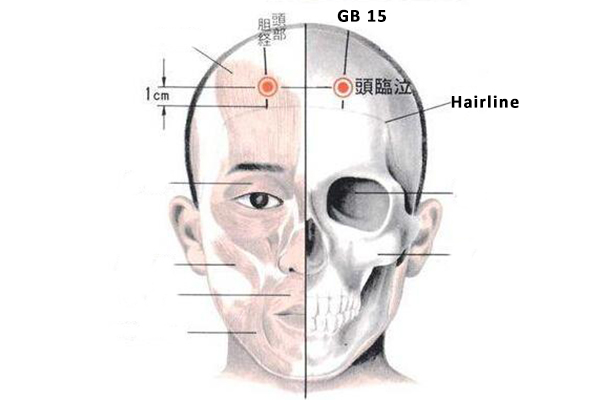
Usage:
Dizziness, headache, stiff neck pain, tinnitus, deafness, bitter taste in mouth.
Clinical:Vascular (nervous) headache, neurotic tinnitus, goiter, etc.
GB 12 Acupuncture Point(Wangu)
Location:In a depression posterior and inferior to the mastoid process.
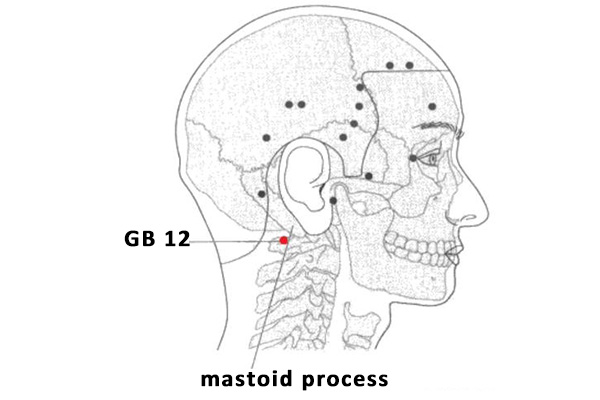
Usage:
- stiff neck pain, cheek swelling, throat disorder, dental caries, facial paraysis, epilepsy, malaria.
- Trigeminal neuralgia, migraine, neck pain, etc
Clinical:Facial nerve palsy, mumps, tonsillitis, insomnia, etc.
GB 13 Acupuncture Point(Benshen)
Location:0.5 cun within the hairline of the forehead, 3 cun lateral to GV 24 (junction of medial 2/3 and lateral 1/3 distance from GV 24 to ST 8).
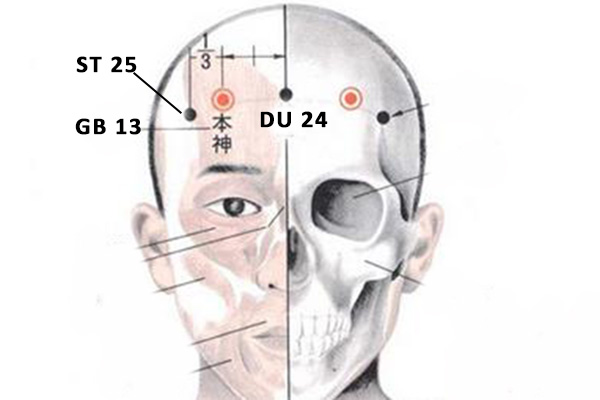
Usage:
1. Headache, dizziness;
2. Epilepsy, convulsion, stroke;
3. Insomnia.
Clinical:vascular (neurological) headaches, cerebrovascular diseases, neurasthenia, cerebral dysgenesis of children.
GB 14 Acupuncture Point(Yangbai)
Location:On the forehead, directly above the pupil, 1 cun above the midpoint of the eyebrow.
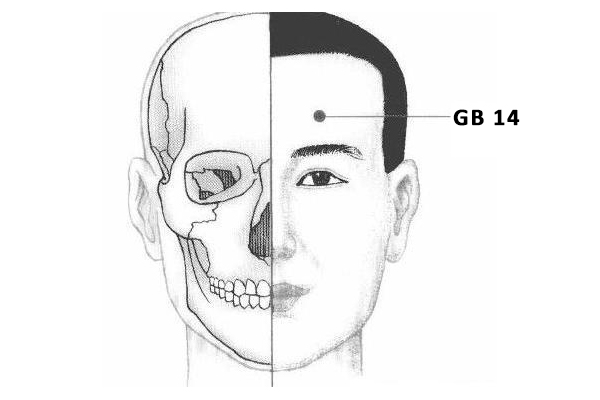
Usage:swelling and pain of eye, drooping eyelids, facial paralysis, headache and other diseases.
Clinical:Supraorbital neuralgia, drooping eyelids, facial nerve palsy, etc.
GB 15 Acupuncture Point(Toulinqi)
Location:On the head, directly above the pupil, 0.5 cun above the anterior hairline at the midpoint of a line connecting GV 24 to ST 8 (directly above GB 14).

Usage:
- Head and facial disorder such as headache, dizziness, tearing, nasal congestion, deafness, etc.;
- Epilepsy;
Clinical:Myopia, supraorbital neuralgia.
GB 16 Acupuncture Point(Muchuang)
Location:On the head, 1.5 cun posterior to GB 15, 2 cun above the anterior hairline and 2.25 cun lateral to the midline of the head.
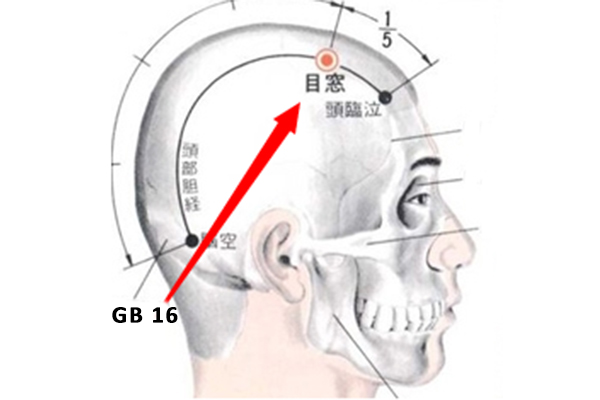
Usage:
- Headache, dizziness, swelling and pain of eye, and glaucoma;
- Epilepsy.
Clinical:vascular (neurological) headaches, conjunctivitis, glaucoma, etc;
GB 17 Acupuncture Point(Zhengying)
Location:On the head, 3.5 cun above the anterior hairline and 2.25 cun lateral to the midline of the head (1.5 cun posterior to GB 16).
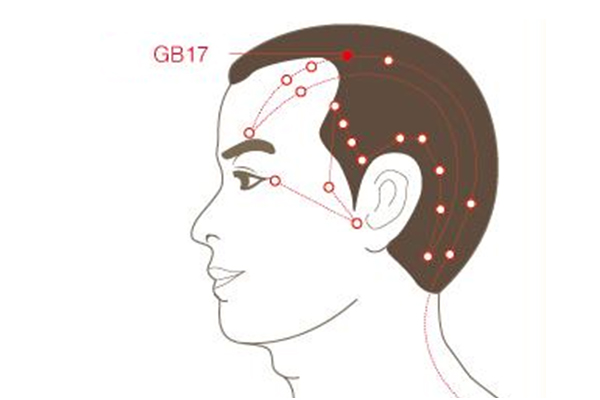
Usage:
Headache, dizziness, dizziness, stiff tongue, toothache.
Clinical:Vascular (nervous) headache, toothache, etc.
GB 18 Acupuncture Point(Chengling)
Location:On the head, 5 cun above the anterior hairline and 2.25 cun lateral to the midline of the head (1.5 cun posterior to GB 17).
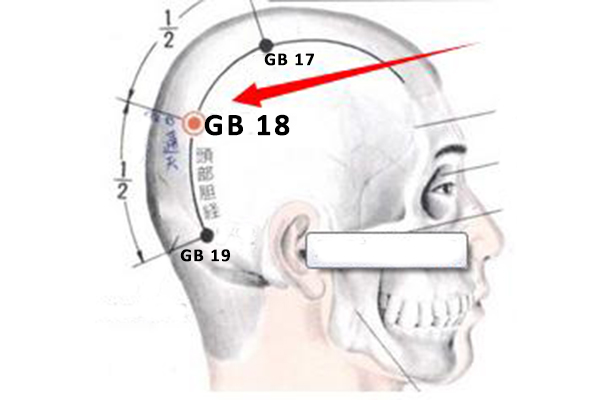
Usage:
Headache, dizziness, sinusitis, epistaxis, tinnitus, stiff neck etc.
Clinical:Vascular (nervous) headache, rhinitis, etc.
GB 19 Acupuncture Point(Naokong)
Location:On the head and level with the upper border of the external occipital protruberance or DU 17, 2.25 cun lateral to the midline of the head (directly above GB 20, level with DU 17);
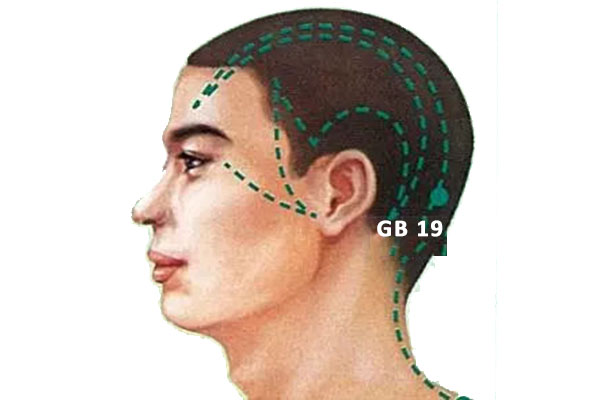
Usage:
1. Headache, dizziness;
2. Stiff neck pain;
3. Epilepsy, palpitations.
Clinical: hysteria, epilepsy, neck soft tissue diseases, etc.
GB 20 Acupuncture Point(Fengchi)
Location:In a depression between the upper portion of the sternocleidomastoid muscle and the trapezius, level with GV 16.
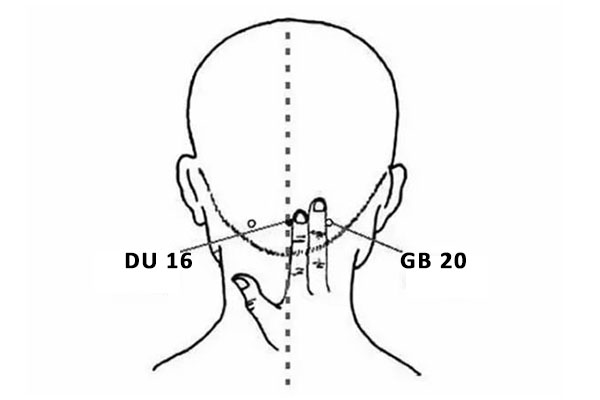
Usage:
- Head and face syndromes such as headache, dizziness,swelling and pain of eye,Sinusitis, tinnitus;
- Mental diseases such as stroke, insomnia, epilepsy, etc.;
- Stiff neck pain.
Clinical:Hypertension, cerebral arteriosclerosis, neurasthenia, epilepsy, colds, optic atrophy, rhinitis, cervical spondylosis, etc.
GB 21 Acupuncture Point(Jianjing)
Location:On the shoulder directly above the nipple at the midpoint of a line connecting GV 14 and the acromion at the highest point of the shoulder.
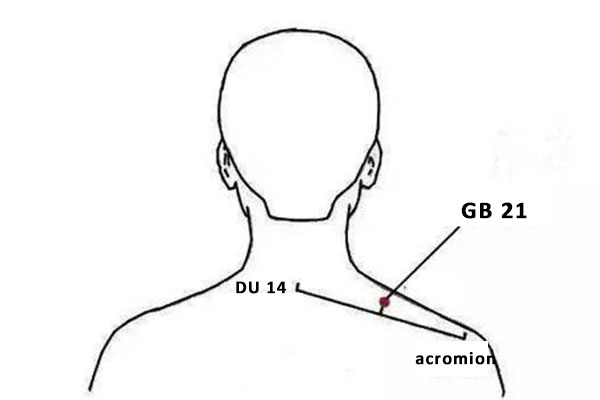
Usage:
- Shoulder and back arthralgia, upper limb paralysis, severe neck pain;
- Scrofula;
- Mastitis, oligogalactia;
Clinical:Soft tissue diseases of shoulder and neck, mastitis, etc.
GB 22 Acupuncture Point(Yuanye)
Location:On the midaxillary line when the arm is raised below the axilla in the 5th ICS (directly below HT 1).
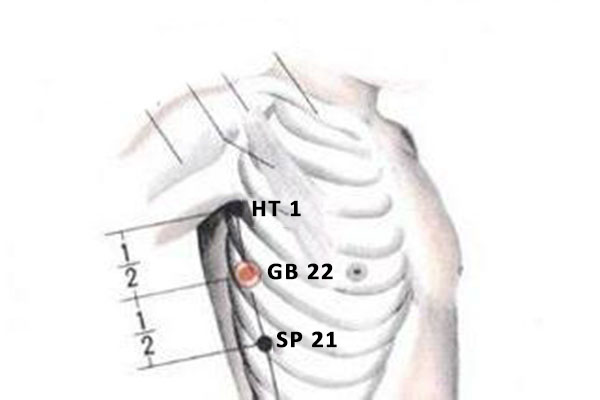
Usage:
1. Full chest and hypochondriac pain;
2. Arm pain in upper limbs.
Clinical:Intercostal neuralgia, pleurisy, costochondritis, axillary lymphatic tuberculosis,etc.
GB 23 Acupuncture Point(Zhejin)
Location:1 cun anterior to GB 22, level with the nipple in the 5th ICS.
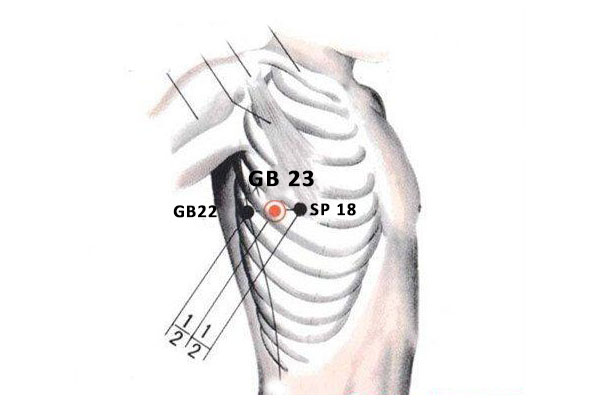
Usage:
1. Chest full and panting.
2. Vomiting and acid regurgitation;
3. Hypochondriac, axillary swelling, shoulder and back pain.
Clinical:Pleurisy, intercostal neuralgia, vomiting, acid regurgitation, neurasthenia, spasm, etc.
GB 24 Acupuncture Point(Riyue)
Location:Directly below the nipple in the 7th ICS, 4 cun lateral to the AML.
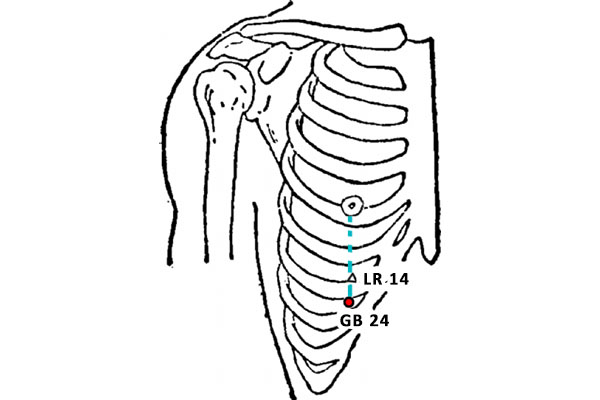
Usage:
- Jaundice, hiccups, vomiting, acid regurgitation, and flank pain;
- Stomach pain.
Clinical:Cholecystitis, hepatitis, intercostal neuralgia, etc.
GB 25 Acupuncture Point(Jingmen)
Location:On the lateral side of the abdomen on the lower border of the free end of the 12th rib.
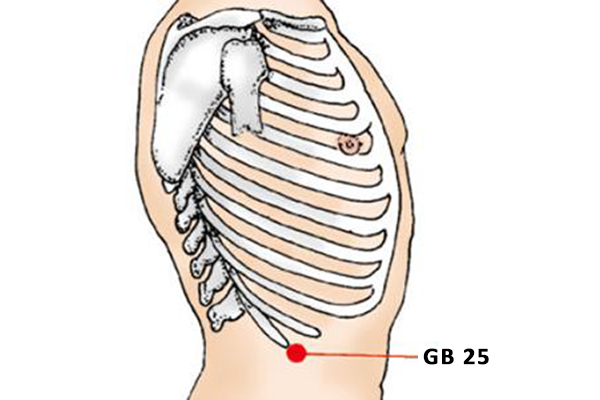
Usage:
1. Difficulty in urination, edema;
2. Hypochondriac, low back pain;
3. Abdominal distension, diarrhea, bowel, vomiting.
Clinical:Nephritis, hypertension, shingles, etc.
GB 26 Acupuncture Point(Daimai)
Location:Directly below LV 13 at the crossing point of a vertical line through the free end of the 11th rib and a horizontal line through the umbilicus (level with CV 8).
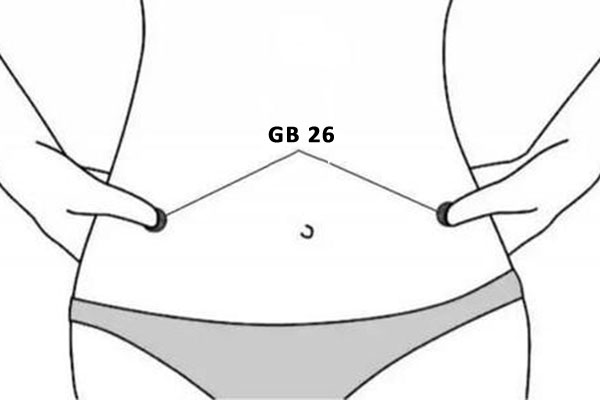
Usage:
- Gynecological diseases such as irregular menstruation, vaginal discharge, amenorrhea, abdominal pain, etc.;
- Hypochondriac pain, low back pain;
Clinical:Annexitis, endometritis, pelvic inflammatory disease, herpes zoster, etc.
GB 27 Acupuncture Point(Wushu)
Location:On the lateral side of the abdomen, anterior to the ASIS, 3 cun below the level of the umbilicus (lateral to CV 4).
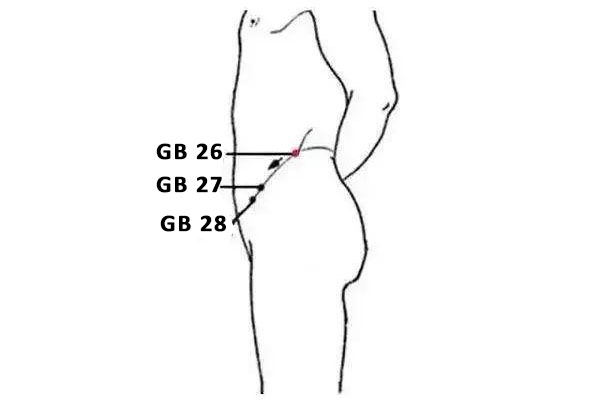
Usage:
- Gynecological syndromes such as vaginal discharge, irregular menstruation, Uterine prolapse, abdominal pain, etc.;
- Hernia;
- Waist and hip pain.
Clinical:Annexitis, endometritis, uterine prolapse, etc.
GB 28 Acupuncture Point(Weidao)
Location:Anterior and Inferior to the ASIS, .5 cun anterior and inferior to GB 27.
Usage:
- Gynecological diseases such as vaginal discharge, irregular menstruation, uterine prolapse, abdominal pain, etc.;
- Waist and hip pain;
Clinical:Endometritis, adnexitis, pelvic inflammatory disease, uterine prolapse, chronic appendicitis, etc.
GB 29 Acupuncture Point(JuLiao)
Location:In a depression at the midpoint between the prominence of the greater trochanter and the ASIS.
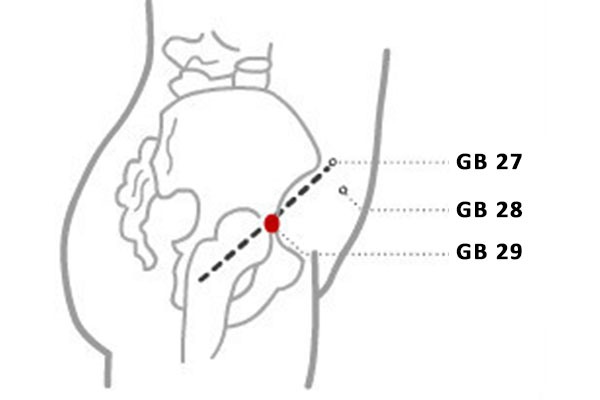
Usage:
1. Lumbar and leg diseases such as waist and hip pain, paralysis of lower limbs;
2. Hernia.
Clinical:Diseases of lumbosacral hip and surrounding soft tissues.
GB 30 Acupuncture Point(Huantiao)
Location:At the junction of the lateral 1/3 and medial 2/3 distance between the prominence of the greater trochanter and the hiatus of the sacrum (GV 2), (located with the patient in a lateral recumbent position with thigh flexed).
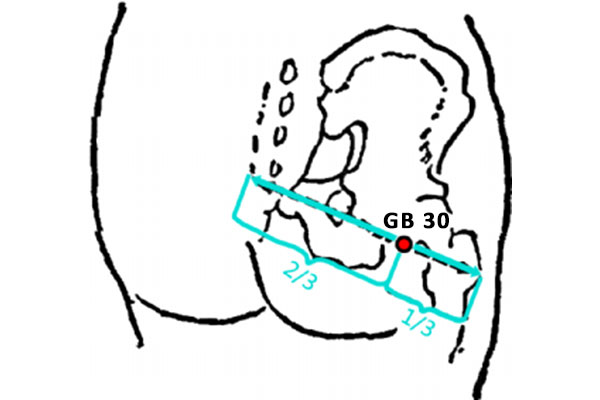
Usage:
- Sciatica, lower limb paralysis, sequelae of cerebrovascular disease, low back and leg pain, hip joint and surrounding soft tissue diseases, athlete’s foot;
- Colds, neurasthenia, rubella, eczema.
GB 31 Acupuncture Point(Fengshi)
Location:On the midline of the lateral aspect of the thigh, 7 cun above the transverse popliteal crease, when patient is standing erect with hands close to sides the point is at the tip of their middle finger.
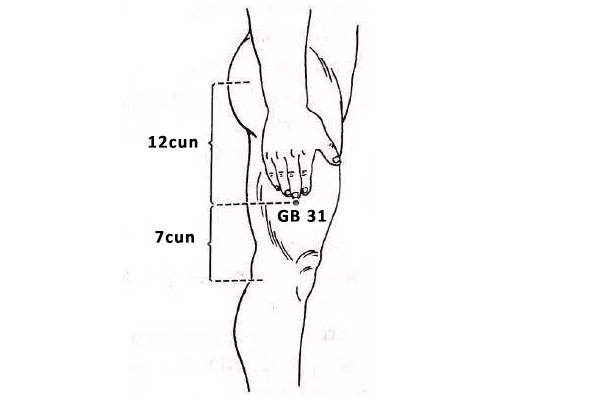
Usage:Hemiplegia, paralysis of lower limbs, lateral femoral cutaneous neuralgia, low back disease and athlete’s foot.
GB 32 Acupuncture Point(Zhongdu)
Location:On the lateral aspect of the thigh, 5 cun above the popliteal crease, 2 cun below GB 31, between the tendons of vastus lateralis and biceps femoris.
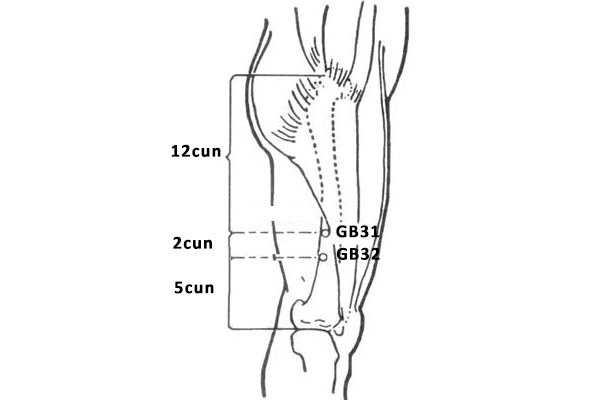
Usage:
Paralysis, numbness of the lower limbs, Hemiplegia.
Clinical:Gallstones, cholecystitis, biliary colic, hemiplegia, sciatica;
GB 33 Acupuncture Point(Xiyangguan)
Location:3 cun above GB 34, lateral to the knee joint, in a depression above the external epicondyle of the femur, between the femur and the tendon of biceps femoris.
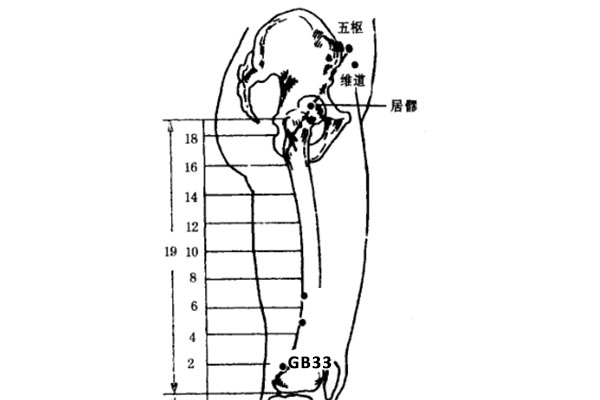
Usage:
- Knee arthritis, paralysis of lower limbs, knee joint and surrounding soft tissue disorders, athlete’s foot;
- Lateral femoral cutaneous nerve palsy, sciatica.
Clinical:Swelling and pain of Knee patella, popliteal contracture, numbness of calf.
GB 34 Acupuncture Point(Yanglingquan)
Location:In a depression anterior and inferior to the head of the fibula.
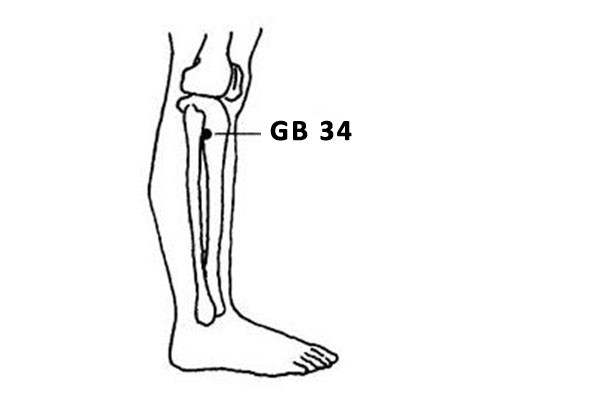
Usage:
Hemiplegia, paralysis of lower limbs, numbness, knee patella pain, athlete’s foot, flank pain, bitter in the mouth, vomiting, jaundice, convulsions.
Clinical: sciatica, hepatitis, cholecystitis, biliary ascariasis, knee arthritis etc;
GB 35 Acupuncture Point(Yangjiao)
Location:7 cun above the tip of the external malleolus on the posterior border of the fibula, level with GB 36 & BL 58.
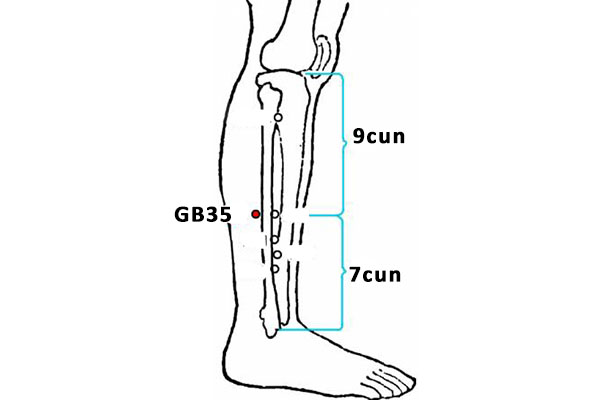
Usage:
Chest distress,Paralysis of lower limbs;
Clinical:Pain or paralysis of superficial peroneal nerve, sciatica, pleurisy, hepatitis, psychosis, etc;
GB 36 Acupuncture Point(Waiqiu)
Location:7 cun above the tip of the external malleolus on the anterior border of the fibula.
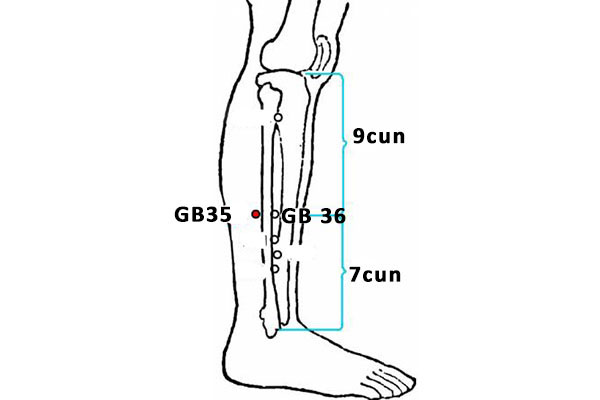
Usage:Stiff neck pain, chest and hypochondriac pain, paralysis of lower limbs, epilepsy, pigeon-breast;
GB 37 Acupuncture Point(Guangming)
Location:5 cun above the tip of the external malleolus on the anterior border of the fibula.
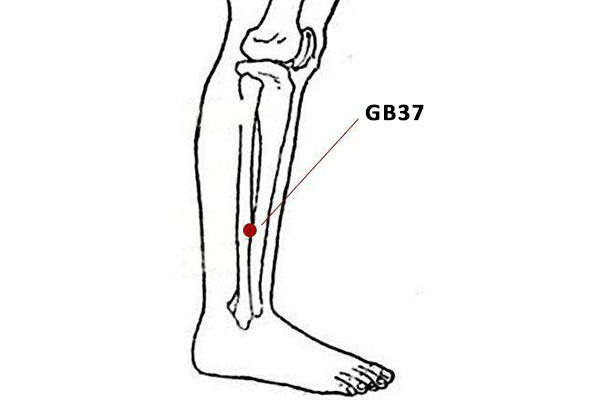
Usage:
itchy eyes, night blindness, sore of leg and knee, paralysis of lower limbs, cold hands and feet.
Clinical:Blue blindness, night blindness, cataract, optic atrophy, migraine, gastrocnemius spasm, etc.
GB 38 Acupuncture Point(YangFu)
Location:4 cun above the tip of the external malleolus, slightly anterior to the anterior border of the fibula between extensor digitorum longus and peroneous brevis.
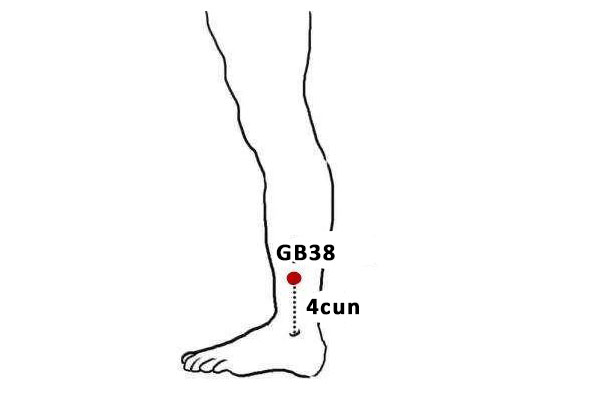
Usage:migraine, pain of the outer canthus, axillary pain, scrofula, chest hypochondriac and lateral pain of lower limbs, malaria, and hemiplegia.
Clinical:Migraine, high blood pressure.
GB 39 Acupuncture Point(Xuanzhong)
Location:3 cun above the tip of the external malleolus in a depression between the posterior border of the fibula and the tendons of peroneous longus and brevis.
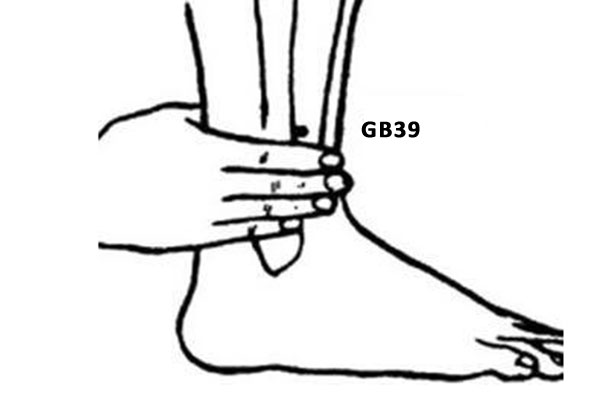
Usage:
fullness of chest and abdomen, stiff neck, migraine, hemiplegia, waist and leg pain, athlete’s foot, sciatica, paralysis of lower limbs.
Clinical:Cerebrovascular disease, hypertension, hyperlipidemia, cervical spondylosis, sciatica, Sydenham etc.
GB 40 Acupuncture Point(Qiuxu)
Location:Anterior and inferior to the external malleolus in a depression on the lateral side of the tendon of extensor digitorum longus.
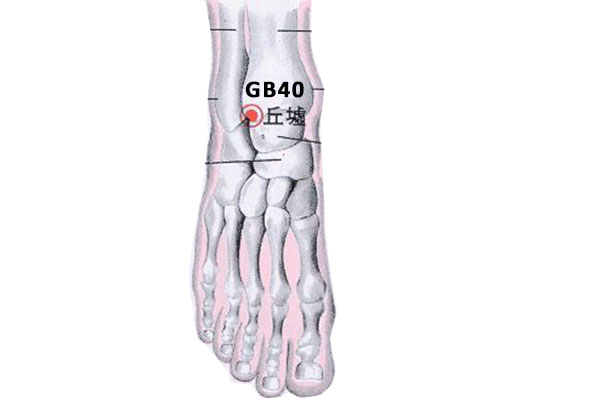
Usage:
Neck pain, underarm swelling, chest and hypochondriac pain, lower limb paralysis, lateral ankle swelling and pain, malaria, hernia,swelling and pain of eye, and stroke hemiplegia;
Clinical:Clam mind, migraine, stroke hemiplegia, paralysis of lower limbs, etc.
GB 41 Acupuncture Point(ZuLinqi)
Location:Posterior to the 4th metatarsophalangeal joint in a depression lateral to the tendon of extensor digiti minimi.
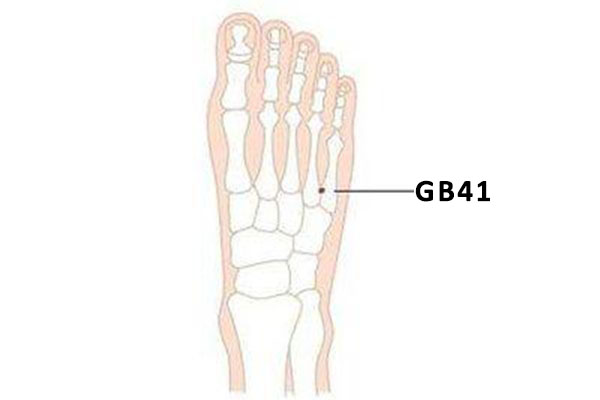
Usage:
- Headache, pain of external canthal, dizziness, mastitis, scrofula, flank pain;
- malaria,;
- Stroke, hemiplegia, arthralgia, foot tarsal pain;
- Low back pain, muscle cramps, eye diseases, cholecystitis, stroke, neurosis, etc.
Clinical:Hypertension, insomnia, headache, intestinal calculus, mastitis, irregular menstruation, cholecystitis, stroke.
GB 42 Acupuncture Point(DiWuhui)
Location:Posterior to the 4th metatarsophalangeal joint between the 4th and 5th metatarsals on the medial side of the tendon of extensor digiti minimi.
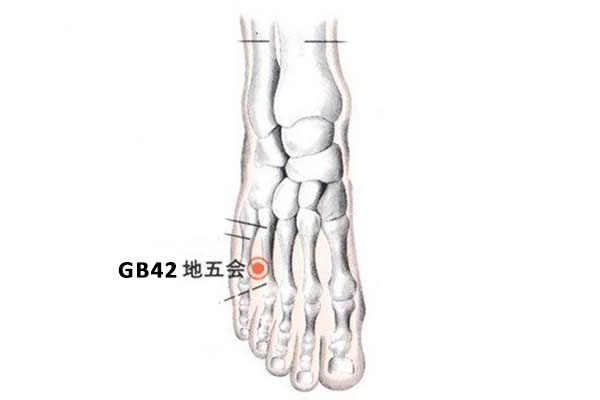
Usage:
- headache, swelling and pain of eye,;
- tinnitus; mastitis, breast swelling; flank swelling and pain, foot tarsal swelling and pain.
Clinical:Tinnitus, mastitis, back pain, foot and back swelling and pain, tuberculosis, vomiting blood, etc.
GB 43 Acupuncture Point(Xiaxi)
Location:On the dorsum of the foot between the 4th and 5th toes, proximal to the margin of the web at the junction of the red and white skin.
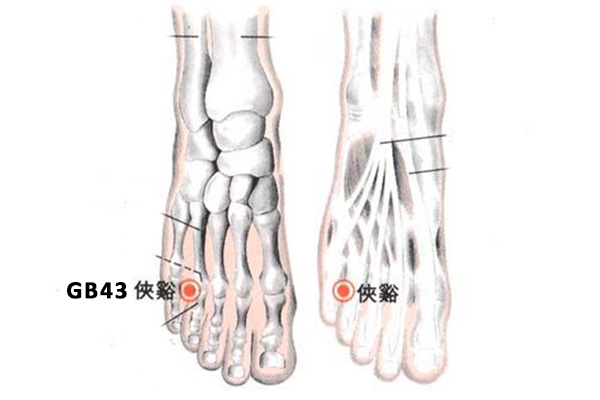
Usage:Headache, dizziness, palpitations, tinnitus, deafness,pain of external canthus, cheek swelling, chest and hypochondriac pain, knee and thigh pain, foot tarsal pain, malaria.
Clinical:headache, tinnitus and deafness, mastitis, hypertension.
GB 44 Acupuncture Point(ZuQiaoyin)
Location:0.1 cun posterior to the corner of the nail on the lateral side of the 4th toe.
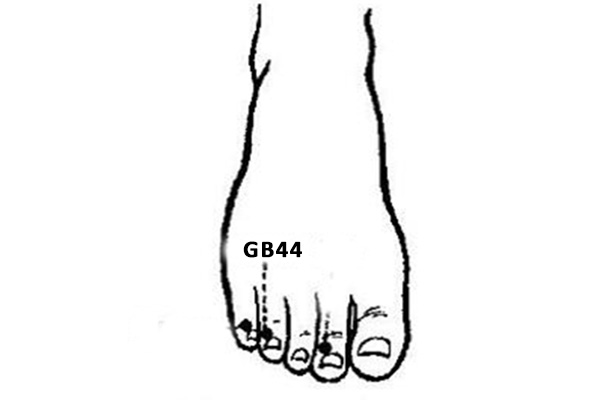
Usage:
Migraine, dizziness, deafness, tinnitus, insomnia, hypertension, intercostal neuralgia, etc.
Clinical:Biliary ascariasis.
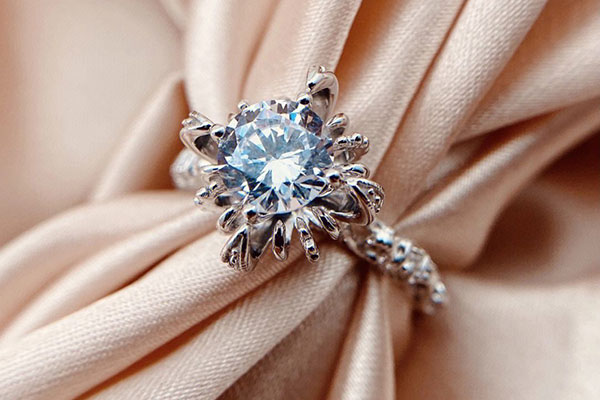
It is really a great and helpful piece of info. I’m glad that you shared this helpful info with us. Please keep us informed like this. Thanks for sharing.